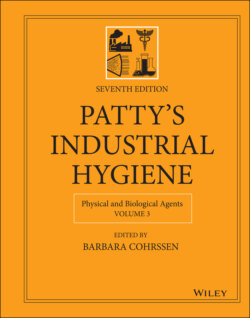Читать книгу Patty's Industrial Hygiene, Physical and Biological Agents - Группа авторов - Страница 101
2.3.1 Measures of Source Output
ОглавлениеThe terms radiant energy Q and radiant power Φ refer, respectively, to the total energy output and the time rate of energy emission of a source. Radiant power is also called radiant flux. The photometric analogues to radiant energy and radiant flux are luminous energy, measured in lumen‐seconds, and luminous flux, measured in lumens.
Radiant intensity I is the radiant flux per unit solid angle emitted by a point source. Solid angle may be pictured as a cone with its vertex at the point source. Solid angle is represented by the symbol Ω. The unit of solid angle is the steradian (sr), which is defined as a solid angle, having its vertex at the center of sphere, that cuts out an area on the surface of the sphere equal to the square of the radius of the sphere. Because the surface area of a sphere of radius r is 4πr2, there are a total of 4π steradians in a sphere. Radiant intensity is measured in watts per steradian. Luminous intensity, the photometric analogue of radiant intensity, is measured in the SI unit candela (cd), which is equal to 1 lm sr−1.
Radiance L is the radiant flux per unit solid angle per unit projected area emitted by an area source. Radiance is measured in watts per steradian per square meter. Luminance, the photometric analogue of radiance, is measured in candelas per square meter. The radiance or luminance of a Lambertian (perfectly diffusing) source is independent of the direction of emission.
Radiant exitance M is the radiant flux per unit area emitted by an area source. It may be noted that radiant exitance is the integral over a hemisphere of the radiance of an area source (9), which for a flat Lambertian source is
(5)
where the solid angle is expressed in terms of an integral over the spherical coordinates θ and φ (the elevation angle and the azimuthal angle, respectively, in radians) and the factor cos θ accounts for the projection of a differential area of the source on any differential element of the hemisphere. The photometric analogue of radiant exitance is the luminous exitance, measured in lumens per square meter. Emittance is an older term for exitance.
The radiometric and photometric terms relating to source output are summarized in Table 1 (part (a)). The radiometric terms and their defining relationships are illustrated in Figure 3.
